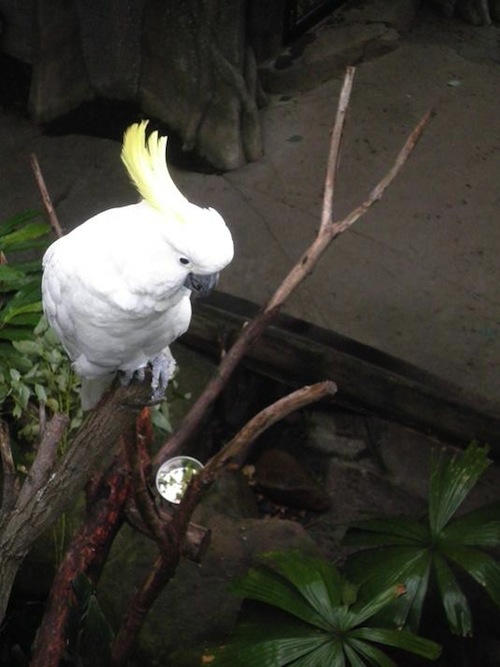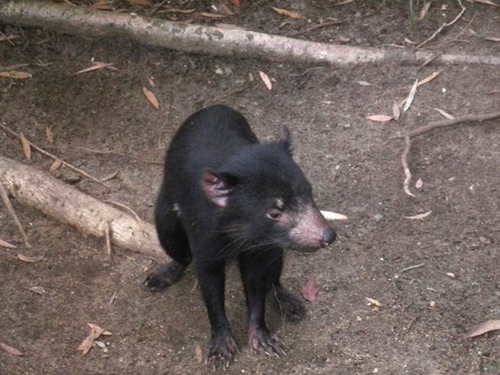G'day mates! Welcome back once again to my Australian wildlife tour. For part four this week three more animals are being showcased. They are the bilby, the sulphur crested cockatoo and the Tasmanian devil. All these exotic animals are native to Australia and have their own unique stories, appearances and facts to be shared with you today. In this particular article, all the photos were taken at a wildlife sanctuary. The photo of the sulphur crested cockatoo was taken by my dad and the rest by me. Sit back, get comfy and enjoy the tour.

Some people in Australia say it's not the Easter Bunny that delivers eggs on Easter, but the Easter bilby! This next animal, called the bilby is critically endangered. These cute little creatures used to cover two thirds of Australia and now only live in deserts. One of the bilby's biggest threats is the introduction of feral animals. Rabbits, foxes, dogs, cattle and other introduced species have caused a massive decline in the bilby population. Rabbits consume huge amounts of the vegetation that bilbies eat and dig burrows that cave in bilby habitats.
The bilby gets its moisture from the food it eats since there is little surface water in the desert environments where it lives. A bilby's diet consists of insects, fruit and other vegetation. The bilby is a type of bandicoot and an Australian marsupial. Like most other marsupials, the bilby is nocturnal, meaning it emerges from its burrow at night when the temperature is cooler.
The one shown sleeping in the photo above was photographed at a wildlife sanctuary. I was incredibly lucky to take a picture of one so clear and close to camera. On Easter, chocolate bilbies can be bought in Australian shops instead of rabbits. This shows support for saving the iconic animal and part of the proceeds are donated to the Save the Bilby Fund. Helping save a native animal could never be more delicious!

This is a photo taken by my dad at a wildlife sanctuary of a talking sulphur-crested cockatoo. I was nonplussed because as soon as we walked near the parrot my dad suddenly shouted at the bird "Hello! How are ya cocky?" I jumped in surprise when it responded back to him with a friendly "Hello!" We stayed with it for a while asking how its day had been and if Polly wanted a cracker. It was a very friendly bird!
Sulphur-crested cockatoos make great pets to some. They can live for over 70 years making them a life-long commitment and companion. These birds are extremely loud, intelligent, energetic, sweet and affectionate with a hint of cheekiness when the time calls for it. Keeping one as a pet requires much more work than a cat or dog. In the wild these birds spend most of their day harvesting for grains, seeds, insects and any other tasty morsels they may find.
Cockatoos breed once a year usually between December and March when food is readily available. The male will ruffle his feathers, spread his wings and bounce around. Once he is accepted by a female they will strengthen their bond by helping preen and scratch each other's feathers. They will form a close bond that lasts a lifetime. If true mates are separated they may experience strong feelings off depression. Both parents take turns to incubate a clutch size of 2-3 eggs over about 30 days. Usually they will only raise the first healthy chick that hatches.

You are probably familiar with the character 'Taz' from Looney Tunes who is based on the real-life animal shown in this photo, the Tasmanian devil. The Tasmanian devil may look cute, but the name says it all. It can look and sound extremely fierce. Early settlers described these animals as 'devils in the night' because of their bloodcurdling screeches, jet black color and easily enraged temper.
Tassie devils have some of the most bone crushing jaws on earth. They have an important role as the 'forest janitors' in keeping the bush clean of dead carcasses. During the daytime they hide in a den and come out at night in search of sick, dying and dead animals. Everything is consumed on the carcass including bones, organs and hair. Often they will scream and growl loudly at each other when feeding off the same carcass.
Tasmanian devils were once found all over Australia but now only in Tasmania. In 2008, Tassie devils were deemed as endangered species. The greatest threat these animals face today is 'devil facial tumor disease' which is passed on by devils biting one another. Usually Tasmanian devils mate in March and the young, called pups are born in April. Only four of the raisin sized offspring are able to be accommodated in the mother's pouch. It's a race to survive for newly born devils. Their first few moments of life are spent in the desperate fight to find a place in the mother's pouch. Nearly 90% of the losers die almost immediately.
The bilby, sulphur-crested cockatoo and Tasmanian devil are all exotic and interesting animals. To me, receiving a chocolate bilby on Easter is better than a bunny. It's not every day you meet a talking sulphur-crested cockatoo! It's fascinating how the fierce Tasmanian devil has a horrific first few moments of life. I hope you enjoyed learning about these animals as much as I did. Stay tuned for next week as there are still more creatures to come.
Author's Note: For more information about these animals go to the sources below:
Bilby:
http://www.kidcyber.com.au/topics/bilby.htm
http://members.optusnet.com.au/bilbies/About_Bilbies.htm
Sulphur-crested Cockatoo:
http://www.kidcyber.com.au/topics/cockatoosc.htm
http://www.billabongsanctuary.com.au/aussie_animals/sulphur_crested_Cockatoo.html
Tasmanian Devil:
http://www.kidcyber.com.au/topics/tasdevil.htm
http://animals.nationalgeographic.com.au/animals/mammals/tasmanian-devil/